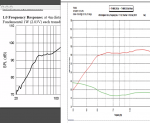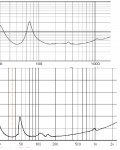Re: Subwoofer comparison SRX728 vs Vertec 4883


After further thought, I don't see any harm in posting the graph from JBL, so here it is. As far as I can tell it is unprocessed. It looks very different than the processed graph in the 4883 spec sheet.Was that graph with or without processing applied?
Agreed on all counts. The measured graph from JBL says that 2.83v are applied to both 8ohm drivers in parallel, so this is a 2 watt measurement at 4 meters, meaning we need to add 6dB to the graph to get a 1w/1m equivalent.If you only see the processed graph-then you have no idea what the raw response of the cabinet is-especially down low. It is VERY common these days for manufacturers to put a boost down low to make the cabinet appear to go lower.
yes it can do that-at the lower levels-HOWEVER-if you turn the cabinet up, whatever boost you have applied (often 6dB or more) HAS to be subtracted from the max output (at the freq it is applied)-because the driver simply can't handle it.
And then the whole "1 watt thing" goes out the window-as they are no longer appling 1 watt to the cabinet for the graph.
I have no idea which way is which-but the previous graph say 'processed"-so that really doesn't say a whole lot.
I like the way EAW does on a lot of cabinets (sadly not all). They show you the unprocessed response-the processors response (where you can easily see the bossts that may be applied) and the final result.
With the unprocessed graph-you gan get a better idea of the cabinet is actually capable of doing-especially when turned up.
This gives way more information than a simple processed response. I would HOPE that a processed response is pretty flat-if not-something is wrong.
Of course HF boosts are also common-but most people don't seem to care about that as much. But that can also add additional heating to the voice coil-and additional distortion because you are asking the driver to do something it can't-at least easily. And the HF boosts aren't as likely to cause damage (at least as much as the low freq boosts) from overexcursion or overheating.



